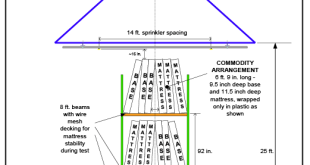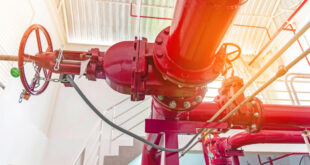The sprinkler industry is similar to many trades with regard to the “dumbing down” of our employees. While I do not state this with a mean intent, I do want us to realize what we are doing. Understanding the issue will help us to adjust our approach and ensure our employees become skilled craftspeople.
SPRINKLER FITTER
Let’s first look at the sprinkler fitter. Years ago, most piping connections were threaded or flanged. Grooved connections were rare. Properly making up a 6-in. threaded or flanged connection took real skill. While grooved connections do require some skill, it is not the same as before. Grooved sprinklers are becoming widely used, along with flexible sprinkler hoses. Sammy®-type attachments have replaced a coach screw, wraparound, eye clips, and similar attachments. When was the last time you ordered or installed a dry pipe, preaction, or deluge valve that was not pre-trimmed or fully assembled and ready to install from the manufacturer? Have you ordered or installed a valve cabinet manufactured with all the equipment already in place, including the trim and alarm/supervisory components already wired and fully tested by the manufacturer?
While I think we can understand why the industry has moved forward with these newer products, it is still important to train the sprinkler fitter on the proper methods of installation for each system component and the limitations of their Listings. Labor savings usually justify the increase in material cost. But are we training the next generation to understand and service this equipment? For example, take a sprinkler fitter with five years of experience in installing new dry pipe, preaction, and deluge systems that were ordered preassembled. A service call is received involving a preaction valve that has an internal issue. Does the fitter have the knowledge to troubleshoot the valve? Without proper training, the answer is likely no, they do not.
LAYOUT TECHNICIAN
Computer automation has brought big changes to the layout process. Today, there are very few sprinkler systems designed without some type of design software. The software might be 2D, 3D, or even 4D, but drawing by hand is becoming a lost skill, similar to our grade schools teaching cursive writing, which was halted in many districts but then returned to the curriculum when it was discovered that students could no longer sign their names to legal documents or read handwritten notes in the real world. Basic skills are essential.
Computer-generated hydraulic calculations have become routine and, in most cases, require little skill to produce acceptable results. While computer programs do make the process easier at a reduced cost, are we producing layout technicians who understand the basics of layout and hydraulic calculations? For the most part, no! NICET and similar certification agencies tell us most candidates struggle with hydraulic calculations and more complex system layouts. Many layout technicians do not understand what the layout software is doing. This leads to a technician guessing how to make a system work hydraulically instead of being able to look at a piping network and know what to change. This is critical as the layout technician is responsible for ensuring that a system complies with the project requirements and NFPA 13, Standard for the Installation of Sprinkler Systems. The layout technician is also responsible for designing a system that is cost-effective for the contractor to install.
In the past, creating a fabrication list meant taking the time to ensure all material was fabricated correctly. Today, pushing a few buttons on the keyboard can generate a fabrication list that is usually accurate as long as the layout is correct. This is a valuable timesaver, but it will not help when a designer is faced with trying to figure out where an entire list may have gone wrong due to a simple input error.
ITM TECHNICIANS
Computer-generated documentation software and checklists have greatly increased the speed, completeness, and accuracy of inspections. The transition from handwritten inspection reports to electronic checklists is inevitable. However, we need to ensure that the ITM technician understands what the box they are checking means and, more importantly, knows what it does not mean. Proper documentation is critical in ITM work.
PROJECT MANAGERS
The role of a project manager is not an easy one but is essential to ensuring a project is successful both from the client and the company perspectives. Specific company and commercial computer software can assist the project manager in their role. While this makes an experienced project manager more efficient and accurate, it does little to train the next generation of project managers in what is important.
SUMMARY
So, what should you do? While we should embrace labor-saving and cost-effective improvements in our industry, reliance on technology can result in the loss of valuable skills. Less experienced employees need a good foundation to succeed in the industry. More experienced employees can benefit from continuing education or cross-training. AFSA trains sprinkler fitters, layout technicians, ITM technicians, and project managers from the ground up. Let us assist you with developing and maintaining the very best industry professionals.
ABOUT THE AUTHOR:

John August Denhardt, P.E., ET, CWBSP, FSFPE, is the vice president of engineering and technical services for the American Fire Sprinkler Association (AFSA). He is responsible for strengthening AFSA’s engineering and technical approaches to meeting member, industry, and operational priorities, with an emphasis on service, quality, and integrity. Denhardt is a registered professional engineer (P.E.) in the District of Columbia and the states of Delaware, Maryland, Pennsylvania, and Virginia. He is NICET Level III certified in water-based systems layout, NICET Level III certified in inspection and testing of water-based systems, and a certified water-based system professional through NFPA. Denhardt is a member of the NFPA 13 technical committee on sprinkler system discharge criteria, a fellow in the Society of Fire Protection Engineers (SFPE), a member of the SFPE Board of Directors, a member of the Board of Trustees for NFPA’s Fire Protection Research Foundation and sits on the University of Maryland Department of Fire Protection Engineering’s Board of Visitors. A native of Maryland, Denhardt holds a Bachelor of Science degree from the University of Maryland College Park in fire protection engineering. Prior to this role, Denhardt was employed by Strickland Fire Protection in Forestville, Maryland, since 1994, overseeing large-scale projects and assisting with design and installation technical issues.
 Sprinkler Age A Publication of the American Fire Sprinkler Association
Sprinkler Age A Publication of the American Fire Sprinkler Association




